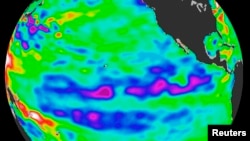The World Meteorological Organization says a La Nina event may develop later this year, but this weather phenomenon, which ushers in cooler temperatures will have no long-lasting impact on climate change.
The El Nino/La Nina weather phenomenon has worldwide regional impacts on rainfall and temperature on a seasonal scale. El Nino causes a warming of the tropical eastern and central sea surface temperatures in the Pacific Ocean and is characterized by warmer temperatures.
Indeed, the strong 2015-16 El Nino that ended in May broke all temperature records for the first six months of the year, putting 2016 on track to be the hottest year on record.
La Nina has the opposite effect. The World Meteorological Organization says La Nina causes large-scale cooling of the ocean surface temperatures in the central and eastern equatorial Pacific, which tends to cool the atmosphere slightly.
WMO’s Climate Prediction and Adaptation Branch head Maxx Dilley tells VOA next year is unlikely to set any heat records if a La Nina does occur later this year.
“This does not mean global warming is not happening anymore if it is not the hottest year on record. These are just slight adjustments to the global temperature that occur due to this oscillation between El Nino and La Nina," he said. "So, if a La Nina occurs we might see just a little bit of attenuation of what we have been seeing, which is record temperatures year after year after year globally.”
WMO says the world now is in a neutral phase, but there is a 50 to 65 percent probability that La Nina will develop in the third quarter of 2016 and last through the end of the year.
Meteorologists say La Nina, which brings above average rain, is likely to offer relief to drought stricken areas including South Asia, eastern Australia, southern and eastern Africa.











